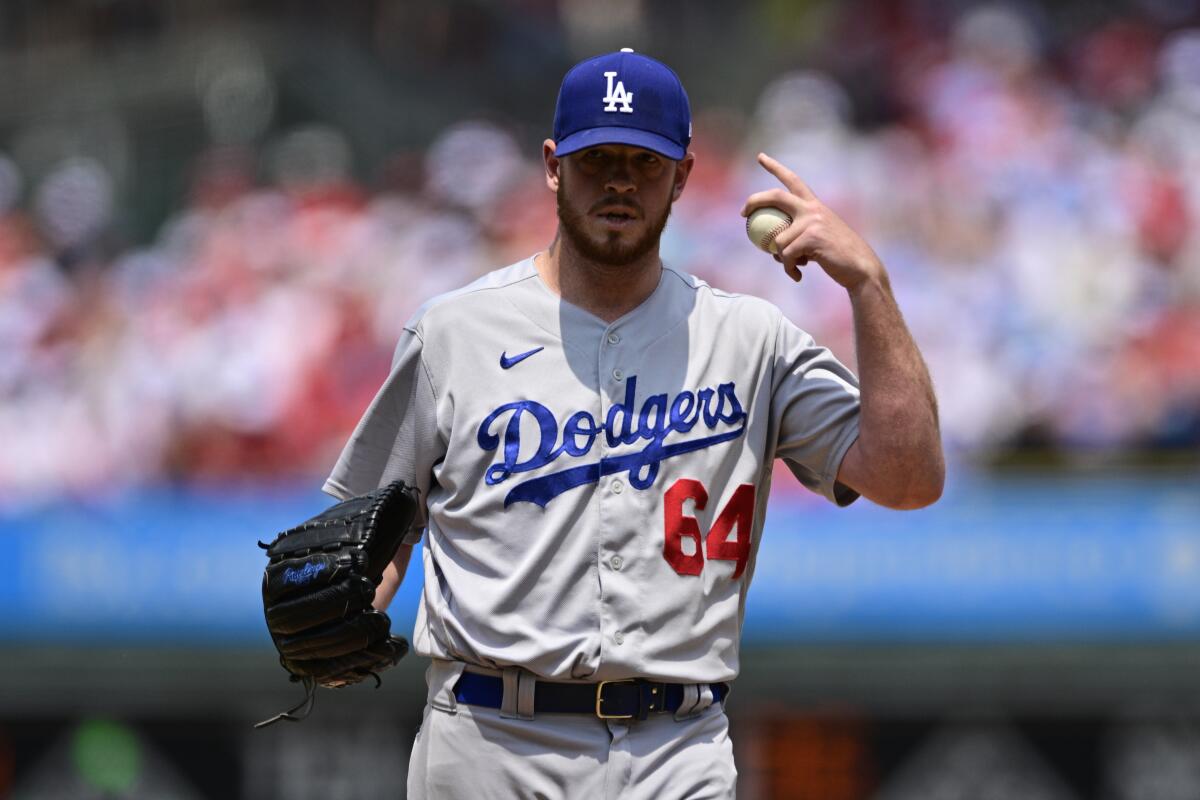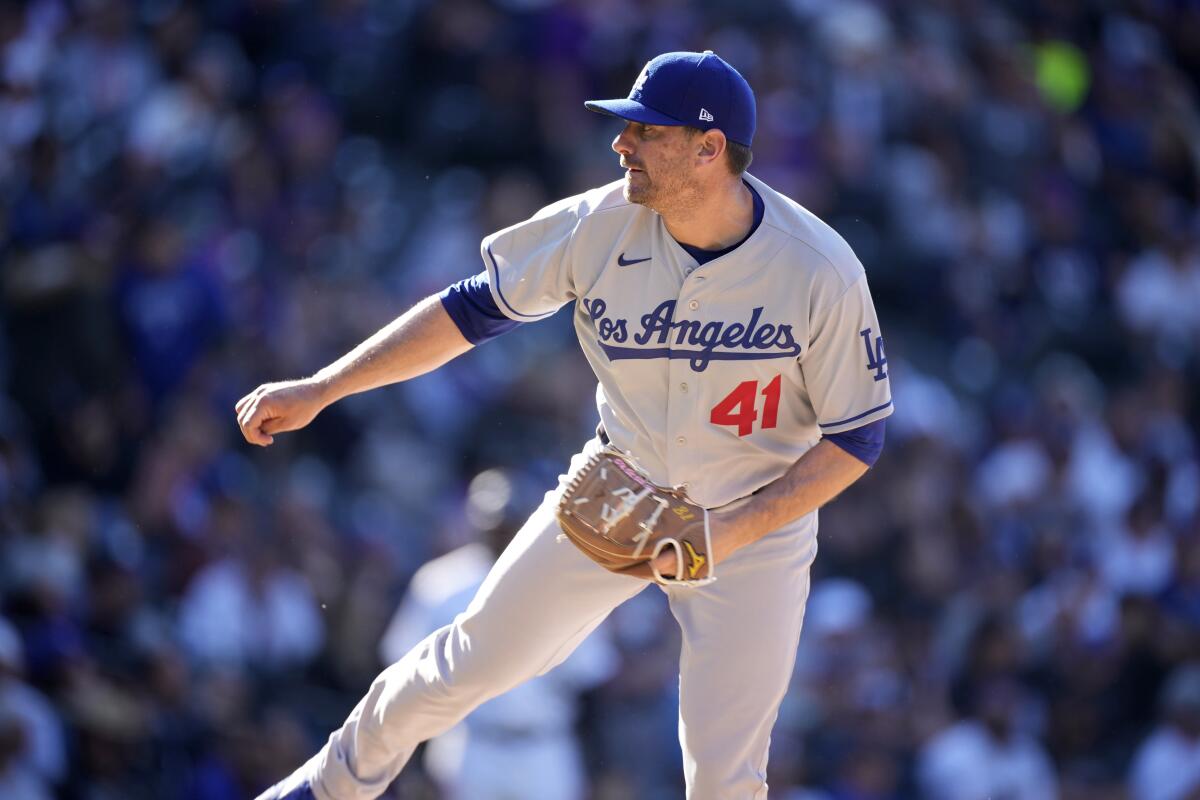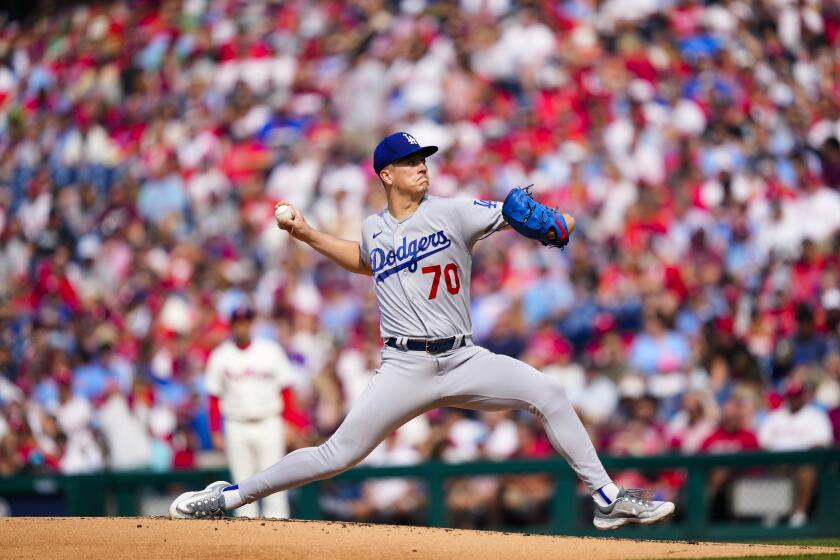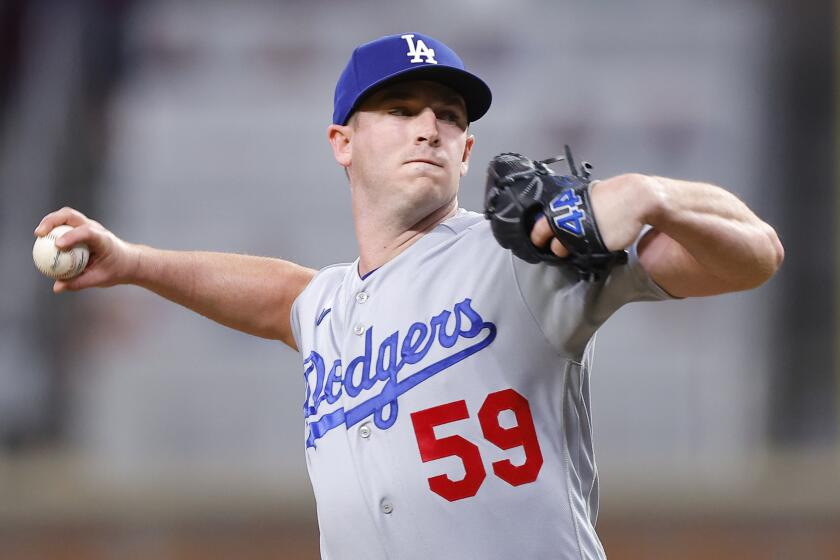Dodgers seek bullpen improvements, but not necessarily a designated closer

Dave Roberts sat in the dugout, scanned the Cincinnati Reds’ lineup and tried to devise a late-game plan.
At the start of their recent six-game trip, the Dodgers had a three-run lead with nine outs to get at Great American Ball Park. Roberts knew the three relievers he wanted to use. But he and his staff still needed to choose how to best line them up.
In past seasons, such decisions were more straightforward: The Dodgers had a set closer (Craig Kimbrel last year, Kenley Jansen before him), a cast of reliable setup men (the role Evan Phillips served last season) and other right- and left-handed options to be deployed in specific, favorable matchups.
In only four major league starts, right-hander Bobby Miller has established himself as an integral part of the Dodgers’ rotation.
This year, however, the team is operating differently. The Dodgers have no designated closer. No set alignment leading up to the ninth inning.
Instead, they’ve tried rearranging their high-leverage pieces on a near-nightly basis.
And after some early-season struggles, then a short-lived turnaround, the bullpen is in danger of devolving into a mess again.
In that Cincinnati game, the Dodgers burned Phillips against the Reds’ top hitters in the eighth — only to watch Caleb Ferguson come unglued in the ninth, giving up three runs with wild command in a walk-off loss.
The next game, it was Phillips who faltered late, responsible for another walk-off defeat to the Reds by giving up a ninth-inning home run.
The Dodgers suffered three walk-off losses on the six-game trip, an additional defeat in which they gave up seven runs in a bullpen game Sunday, and returned home with an earned-run average of 4.76 from their relievers on the season, fourth worst in the majors.
The bullpen’s struggles have helped raise the team ERA to 4.49. Both marks would be the worst for a full season since the Dodgers moved to L.A.
In the wake of those struggles, speculation arose in recent days.
About whether the team needs to reevaluate its closer situation. And whether choosing a consistent option in the ninth inning, and lining up a more regimented plan preceding it, would help the overall performance of the unit.
Posed those questions over the weekend, Dodgers decision-makers downplayed such a narrative.
“We feel like we have the talent down there to navigate close games and win them,” president of baseball operations Andrew Friedman said. “If you have a designated closer, that’s helpful in a lot of ways. But I also think it can be harmful if you force that.”
Friedman sees the Dodgers in the latter category.
“I’m not sure our personnel sets up perfectly, right this second, for a designated closer,” he said.
Roberts made a similar point, noting that though Phillips (who has a team-high seven saves with a 2.66 ERA) would be a logical closer candidate, keeping the right-hander available for other situations has critical benefits.
“I just think right now, where we’re at,” Roberts said, “it’s got to be fluid.”
Instead, the Dodgers’ main focus now is finding more high-leverage alternatives for their late-game puzzle.
They hoped Brusdar Graterol (who has a 1.95 ERA but has made several costly defensive mistakes) and Ferguson (whose ERA has risen to 3.91 amid a recent slump) could fill those voids.
But as they try to end a 10-14 skid that has dropped them to second place in the National League West, the Dodgers have started seeking out other options.
And, when looking internally, both Roberts and Friedman believe there are potential breakout candidates.
Yency Almonte and Alex Vesia, both high-leverage relievers last season, have shown improvement after woeful opening months. Shelby Miller and Victor González have been rewarded with increased roles for their steady performances.
Veteran right-hander Daniel Hudson offers another hope. After a series of delays and setbacks in his recovery from a torn anterior cruciate ligament suffered last June, the 36-year-old has finally begun a rehabilitation assignment in the Arizona Complex League and could return to the majors in a matter of weeks, according to Roberts.
“Obviously, we’re not gonna put him in harm’s way,” Roberts said of Hudson, who was a key cog in last year’s bullpen before getting hurt. “But everything I’ve heard from the training staff, I know Huddy is anxious to get back.”

Beyond that, the Dodgers’ answers run thin.
Offseason signing Alex Reyes is set to miss the whole season because of a shoulder surgery. Other injured relievers like Jimmy Nelson, Blake Treinen and J.P. Feyereisen are uncertainties at best to make impactful contributions this year.
Because of that, the bullpen is likely moving up on the Dodgers’ trade deadline shopping list.
Last season, they acquired an uncovered gem in Chris Martin on the cheap. In previous seasons, they have used the trade market to bolster their reliever depth.
Making a bigger splash this summer could be wise, especially if the club wishes to keep Phillips in his versatile fireman role — entering games in either the biggest situation or against an opponent’s best hitters, regardless of the inning.
“I don’t think it’s smart to put ourselves, myself or Evan in a situation where it’s all or nothing,” Roberts said of preserving Phillips’ current role instead of using him strictly in the ninth inning.
Regardless of potential additions over the next couple of months, Roberts put the onus on the team’s current relievers to simply pitch better.
“You have to peel back individual performance,” he said. “And I think that individually, guys are not pitching to their capabilities.”
For Graterol, it means continuing his ever-confounding efforts to induce more strikeouts, especially with his whiff rate at its lowest point in three seasons.
For Ferguson, it’s about keeping his poise in high-pressure situations and avoiding the kind of ninth-inning meltdown that set a dour tone for the rest of the recent trip.
Vesia had to readjust his routine on the mound after the introduction of the pitch clock this season, noting he used to take time to close his eyes and visualize his plan of attack during at-bats.
Their high-leverage relievers have mostly been effective, but as a group the Dodgers’ bullpen has some of the worst numbers in Major League Baseball.
Both he and Almonte have tried to be more consistent with their sliders as well, tinkering with their mechanics in hopes of landing it for more strikes.
“We can go through each guy, and we feel like there are really compelling [potential] upside stories,” Friedman said. “Successful paths that we can help set these guys on.”
The Dodgers’ top executive then offered a qualifier — underlining the urgency with which the team is approaching its recent inconsistencies in the bullpen.
“Obviously, if that doesn’t happen, then we’re gonna have to figure out either internally or externally how to improve,” Friedman said. “But we feel like we have the talent internally to get there, and then couple that with some reinforcements.”
More to Read
Are you a true-blue fan?
Get our Dodgers Dugout newsletter for insights, news and much more.
You may occasionally receive promotional content from the Los Angeles Times.











